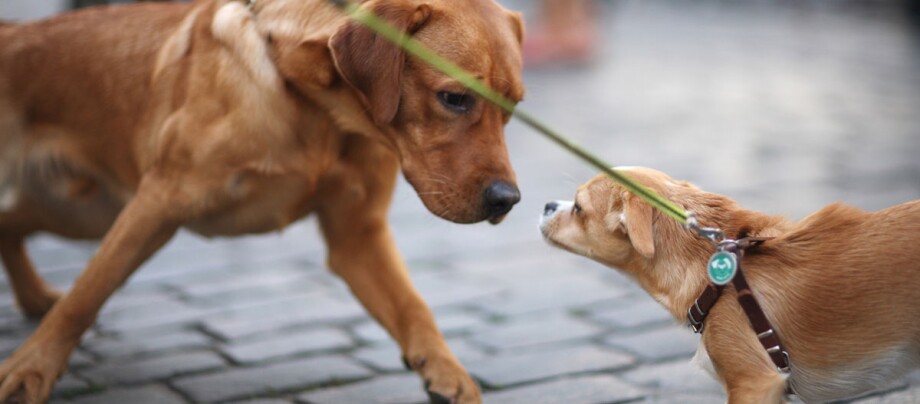Master Contact with Your Dog and Understand Your Dog’s Body Language
07.10.2022 - Reading time: 3 minutes

Dog owners who have had bad experiences with other dogs lean towards putting their pet on a lead as soon as another dog appears. While the fear of meeting other animals is understandable, such encounters are also essential for the social behaviour of the dog. It is therefore important, to read the body language of your pet and also to be relaxed and confident towards other dogs. Find out here how this works.
Understanding our dogs’ body language: the “doggie code book”
It’s best to use training to avoid problems when meeting other dogs by learning how to understand the dogs’ behaviour towards one another. If two, sociable and free-roaming dogs meet then they will follow the “doggie code book”:
Dog interactions
- The dogs approach each other – some carefully, others very boisterously.
- First comes the obligatory sniff test of the genital region, then the dogs will decide if they like, tolerate or want to dominate each other.
- This is a critical moment for dog owners.
Youngsters who still haven’t worked out boundaries lean towards dominant behaviour in puberty. In these instances the dominant dog points their tail upwards, bristles the fur on their back and puts their head or paw on the back of their opposite number. They may attempt to mount the other dog, which is a sign of dominance for both sexes. A calmer dog will try to placate this situation and avoid it. A confident older dog or female will let the young upstart know without hesitation that they will not allow themselves to be dominated.
How you should behave around dog encounters
- Don’t panic if the dogs figure this situation out themselves with a lot of hullabaloo.
- Trust the social instincts of both dogs since this is very natural behaviour for them.
- Don’t shout at your dog as this may spur them on.
- Keep your distance so that you don’t come between them but also so that your dog doesn’t think you need to be defended.
- Don’t be misled by a wagging tail, since this doesn’t necessarily mean friendliness; rather it shows that the dog has become excited.
In most cases the adversaries will leave each other alone after a short round of fisticuffs, at the most leaving a few scratches behind.
Train for meeting other dogs - and set the limits yourself
Contact with other dogs are very important for your pet, especially when it comes to puppies or young dogs. These encounters ensure that young dogs get used to social interactions. However, it should be you who decides how and when these meetings take place.
The aim behind training your dog for these encounters is to make the situation as stress-free as possible for both you and your dog. The cornerstone of the training is to build a strong, positive bond between you and your dog. Searching and fetching games, which can be done every day in the park, are very well suited to getting your dog to see you as an exciting partner. Train your dog to walk past other dogs by such measures as distracting them with their favourite toy. Keep eye contact with your dog. This keeps your pet focussed on you and not on the other animal.
Using well-practised commands such as “sit” or “stop” and calls such as “come” or “here” can help your dog separate themselves from their opposite number in hairy situations. If your dog loves to play with other dogs, you can “ground” them by making them sit before giving the command “go” or “play”. However, never allow your dog to decide how long to play with their friends: that’s up to you.
Avoiding encounters between dogs: tips on behaviour and when it gets serious
There are situations in which interactions between two dogs are not desirable, for example, when one dog is sick, a female dog is in heat or if you have a dog that is anxious or aggressive on the lead.
First and foremost: in all situations you should remain calm and communicate initially with the owner. Ask them expressly to call back their dog if you have your dog on a lead. Never let your dog notice your nervousness or fear, act in a level-headed manner and do not pull anxiously on their lead. Be emotionally ready to meet other dogs and react quickly.
Tips if it gets serious:
- Avoid encounters with other dogs by moving your dog to the side on its lead or walking decisively and quickly past a free-roaming dog, which should only follow you for a short way.
- Keep a trick up your sleeve and open up an automatic umbrella in the direction of the free-roaming dog.
- If it gets serious, dog psychologists such as Martin Rütter suggest letting your dog off the lead when interacting with free-roaming dogs or letting the lead drop and taking a few steps away. This gives your dog the choice of interacting in a suitable manner instead of having to defend their owner.
Interactions between two dogs on leads should be avoided as a rule. You should learn to read the body language as soon as possible. If one of the dogs demonstrably moves away from the other, makes themselves rigid or shows their teeth then both owners should react quickly to move the dogs away from each other at the same time.
If your dog has been bitten, you should ask the other owner for their dog’s vaccination certificate and see a vet as soon as possible so that any potential internal injuries or organ damage to the dog can be treated as quickly as possible.


